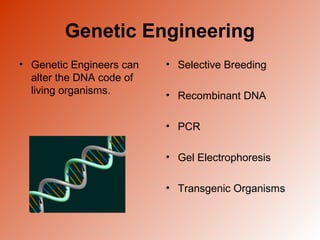Genetic engineering
•Download as PPT, PDF•
3 likes•3,465 views
This document discusses genetic engineering techniques such as selective breeding, recombinant DNA, polymerase chain reaction (PCR), gel electrophoresis, and transgenic organisms. Recombinant DNA allows combining DNA from different organisms and was first used in the 1970s with bacteria. Genetically modified plants and animals are created through insertion of foreign DNA and have applications such as producing human proteins and increasing disease resistance. PCR and gel electrophoresis are techniques used to analyze and identify DNA.
Report
Share
Report
Share

Recommended
More Related Content
What's hot
What's hot (20)
Biology - Chp 13 - Genetic Engineering - PowerPoint

Biology - Chp 13 - Genetic Engineering - PowerPoint
Genetic Engineering: Chapter 1- History of Genetic Engineering

Genetic Engineering: Chapter 1- History of Genetic Engineering
Genetic engineering and recombinant DNA technology

Genetic engineering and recombinant DNA technology
Similar to Genetic engineering
Similar to Genetic engineering (20)
DNA recombinant technology on insulin modification

DNA recombinant technology on insulin modification
Genetic Engineering By Ghawas khan from AWKUM Pharmacy

Genetic Engineering By Ghawas khan from AWKUM Pharmacy
More from Naveen Gupta
More from Naveen Gupta (13)
Recently uploaded
Recently uploaded (20)
Asymmetry in the atmosphere of the ultra-hot Jupiter WASP-76 b

Asymmetry in the atmosphere of the ultra-hot Jupiter WASP-76 b
Formation of low mass protostars and their circumstellar disks

Formation of low mass protostars and their circumstellar disks
Recombination DNA Technology (Nucleic Acid Hybridization )

Recombination DNA Technology (Nucleic Acid Hybridization )
VIRUSES structure and classification ppt by Dr.Prince C P

VIRUSES structure and classification ppt by Dr.Prince C P
Unlocking the Potential: Deep dive into ocean of Ceramic Magnets.pptx

Unlocking the Potential: Deep dive into ocean of Ceramic Magnets.pptx
fundamental of entomology all in one topics of entomology

fundamental of entomology all in one topics of entomology
Labelling Requirements and Label Claims for Dietary Supplements and Recommend...

Labelling Requirements and Label Claims for Dietary Supplements and Recommend...
Hubble Asteroid Hunter III. Physical properties of newly found asteroids

Hubble Asteroid Hunter III. Physical properties of newly found asteroids
PossibleEoarcheanRecordsoftheGeomagneticFieldPreservedintheIsuaSupracrustalBe...

PossibleEoarcheanRecordsoftheGeomagneticFieldPreservedintheIsuaSupracrustalBe...
All-domain Anomaly Resolution Office U.S. Department of Defense (U) Case: “Eg...

All-domain Anomaly Resolution Office U.S. Department of Defense (U) Case: “Eg...
Physiochemical properties of nanomaterials and its nanotoxicity.pptx

Physiochemical properties of nanomaterials and its nanotoxicity.pptx
Stunning ➥8448380779▻ Call Girls In Panchshil Enclave Delhi NCR

Stunning ➥8448380779▻ Call Girls In Panchshil Enclave Delhi NCR
Genetic engineering
- 1. Genetic Engineering • Genetic Engineers can alter the DNA code of living organisms. • Selective Breeding • Recombinant DNA • PCR • Gel Electrophoresis • Transgenic Organisms
- 2. Selective Breeding • Breed only those plants or animals with desirable traits • People have been using selective breeding for 1000’s of years with farm crops and domesticated animals.
- 3. Recombinant DNA • The ability to combine the DNA of one organism with the DNA of another organism. • Recombinant DNA technology was first used in the 1970’s with bacteria.
- 4. Recombinant Bacteria 1. Remove bacterial DNA (plasmid). 2. Cut the Bacterial DNA with “restriction enzymes”. 3. Cut the DNA from another organism with “restriction enzymes”. 4. Combine the cut pieces of DNA together with another enzyme and insert them into bacteria. 5. Reproduce the recombinant bacteria. 6. The foreign genes will be expressed in the bacteria.
- 5. Benefits of Recombinant Bacteria 1. Bacteria can make human insulin or human growth hormone. 1. Bacteria can be engineered to “eat” oil spills.
- 6. The DNA of plants and animals can also be altered. PLANTS 1. disease-resistant and insect-resistant crops 2. Hardier fruit 3. 70-75% of food in supermarket is genetically modified.
- 7. How to Create a Genetically Modified Plant 1.Create recombinant bacteria with desired gene. 2. Allow the bacteria to “infect" the plant cells. 3. Desired gene is inserted into plant chromosomes.
- 8. Genetically modified organisms are called transgenic organisms. TRANSGENIC ANIMALS 1. Mice – used to study human immune system 2. Chickens – more resistant to infections 3. Cows – increase milk supply and leaner meat 4. Goats, sheep and pigs – produce human proteins in their milk
- 9. Transgenic Goat Human DNA in a Goat Cell . This goat contains a human gene that codes for a blood clotting agent. The blood clotting agent can be harvested in the goat’s milk.
- 10. How to Create a Transgenic Animal Desired DNA is added to an egg cell.
- 11. Polymerase Chain Reaction PCR • PCR allows scientists to make many copies of a piece of DNA. 1. Heat the DNA so it “unzips”. 2. Add the complementary nitrogenous bases. 3. Allow DNA to cool so the complementary strands can “zip” together.
- 12. Gel Electrophoresis • This technology allows scientists to identify someone’s DNA!
- 13. Steps Involved in Gel Electrophoresis 1. “Cut” DNA sample with restriction enzymes. 2. Run the DNA fragments through a gel. 3. Bands will form in the gel. 4. Everyone’s DNA bands are unique and can be used to identify a person. 5. DNA bands are like “genetic fingerprints”.
